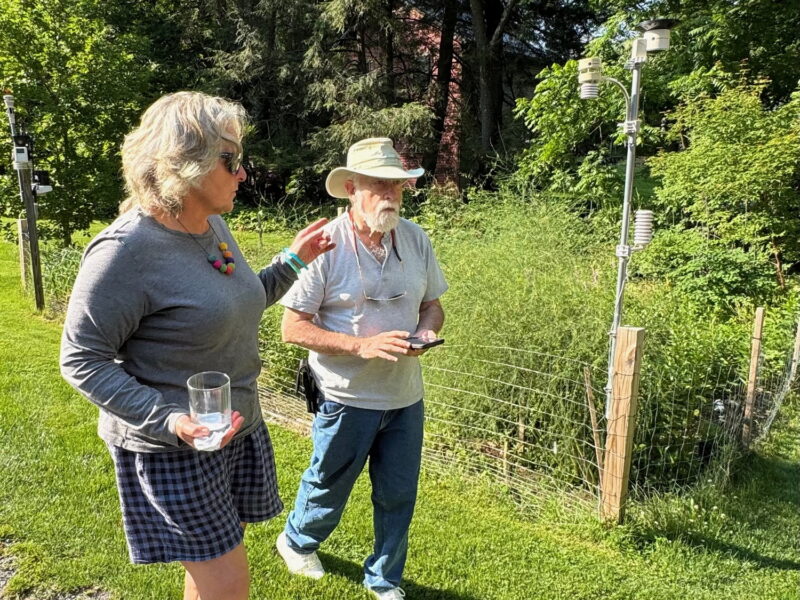

Once upon a time long, long ago I took a graduate course at Southampton College as one of the requirements to get my permanent certification as, of all things, an English teacher. No, my degrees aren’t in horticulture but in English and journalism.
The woman I was dating at the time was also in this class and knew I had a love of plants and gardening. She told me there was an abandoned greenhouse on the campus, and within a year I was managing the college’s Jacob’s Greenhouse. It was then that I began my serious study of horticulture and in addition to reading every textbook I could get my hands on I was mentored by Ralph Freeman, an extension agent at Cornell Cooperative Extension.
It was a number of years later that I proposed to teach a course, an introduction to horticulture, and using the greenhouse and an acre of land around it I began a tropical and temperate collection of woody and herbaceous plants. My course proposal was approved, and the college allowed nonscience undergraduates to take the course as a partial fulfillment of their science credits needed for graduation. The class filled up every semester it was offered, and a second course was added in advanced horticultural practices.
The other aspect of my work was the establishment of the Gardening by the Sea program. We brought in experts from up and down the Northeast coast who were specialists in the area of seaside gardening, both in growing plants and in garden design. The program was a multi-day on-campus learning experience including lectures and field trips. We did this for three years in a row.
My goal was to establish a plant collection with the potential of establishing a botanical garden. It was to be called the Shinnecock Botanical Garden. The college president at the time agreed that the college would match me dollar for dollar in the monies I could raise for the botanical garden. I contacted some local well-heeled families that I knew were into gardening, and overnight I was able to collect checks amounting to $10,000. The college backed down from the agreement seemingly knowing I was able to raise the money needed, and they would never be able to match it.
Nonetheless, my little horticulture program continued, and over the years I taught dozens and dozens of undergraduates the science of horticulture. My goal was to give them the tools to get jobs locally in the horticulture and landscaping fields adding the science of growing, maintaining and protecting plants on the East End. At that time most of the local gardeners were well-meaning Polish and Italian immigrants who relied solely on what they had learned from their parents and peers. Their approach was not, however, based on science or research, and few if any had training on the use of pesticides.
Eventually, my business, a wholesale perennial nursery, grew to the point where I needed more land and my days at the college had to end. I moved the nursery to Flanders where we grew tens of thousands of perennials every year that were sold throughout Long Island and beyond.
In the process, two of my students became friends. One, April Gonzales, still works out here and has a very nice landscape and design business. Sarah Donnely worked on the East End for a while, and these days she maintains her 74-acre property in Massachusetts where she has meadows, woods, ponds and plants galore.
Last weekend Sarah and April came up to visit me at our home in the Catskills and to see my gardens. I had corresponded with April over the years but lost track of Sarah. Oh, what a thrill it was, and what an exciting weekend. Three full days of three plantspeople talking about plants. They arrived with gifts of plants, and I was able to take them to a plant sale where they went wild buying potted natives from a local grower. It was so wonderful and reaffirming, and then I got a note from Sarah a day after they went their separate ways saying she was so happy that I was back in her life. I was so very moved and touched. They made it very clear that my mentoring them gave them careers that have given them pleasure, good fortune and a deep sense of satisfaction.
Now it’s back to work with the help of my assistant Nancy. She’s a great worker but lacks the real horticultural skills and ability to identify untagged perennials that I need. But you can’t have it all, and I’m thankful she’s put up with me for 10 years.
So this all brings me back to the garden and some more rambling thoughts. Back to the plants.
In the spring I brought in about 150 new plants, and they were either bare rooted, in cells, coir pots or plastic pots. It’s the same thing every year as I always buy more than there’s time to plant. Then came the heat wave, and that dashed all thoughts of planting so the challenge was just to keep everything watered and or shaded. There are four flats of columbine seedlings at the picnic table on the front porch and one filled plastic shipping crate. On the back porch are flats of Silene rigida I’d grown from seed collected last year. This is the royal catchfly that showed up out of nowhere. I fell in love with this wildflower so now I have 150 of them. And there’s one more shipping crate with Epimediums and other plants on the back porch as well as a potting bench next to the barn that’s filled with more plants screaming, “Plant me, plant me!”
Why is it too late to plant them? Well, I could, but then I’d have to keep track of every single one of them somehow and water them. Not me. I’ll carry a watering can to take care of a few of them but not nearly 200 spread across an acre of gardens.
Shortly these will all get potted in slightly larger pots to allow them to grow and fill in a bit. They’ll be at home in an area under a Fringe tree atop two inches of crushed bluestone gravel. The tree gives dappled shade, and the gravel under the pots and cells allows me to water the plants and still allow them to drain and not rot. The gravel also keeps the slugs at bay but most of them are cooked by three days of 90-plus-degree heat. The area has a temporary fence to keep the rabbits out.
In late August all these plants will go into their final planting spots. This gives them several months of warm days and cool nights in the garden that will encourage root growth and ensure firm anchoring. By our first frost they will be well set and able to take whatever winter throws at them as long as they get planted and are given enough time to establish.
I have a small circle of Oriental poppies at the front of the property that are eye catchers every year and people still stop to ask what they are. As the poppies fade, they can look a bit sloppy though their foliage and seed pods have some appeal. But just as the poppies fade, the tall stems of Lychnis chalcedonica, the Maltese cross, punch through then bloom atop the three-foot stems in their red/orange glow. This draws the viewer’s gaze away from the fading poppy foliage and right to the glowing red of the Lychnis flowers. It’s a great plant combination to extend this 6-foot-diameter stand-alone garden.
Ah, but there are the same variety of poppies in full bloom just 60 feet away that bloom two weeks later. These are in the front of the house. No trick in the later-blooming poppies but remember that real-estate mantra: It’s location, location, location.
These poppies are on the north side of the house, so they get four hours less sunlight than the poppies in the small round bed. This accounts for their later bloom. Something to consider with your plantings that you want to have an extended season for.
It seems to work with the poppies in these two locations, one getting full sun all day and the other getting four hours less sun. The result is later blooming for the second group. But this won’t always work so be careful and experiment. If the poppies in front of the house got a bit more shade they would never bloom. The stems would elongate and the heavy egg-shaped buds would end up on the ground, rotting and not flowering.
I now cage just about every new plant that goes into the garden. In spite of my best efforts the rabbits have returned en masse. While they enjoy the clover in the lawn they and their groundhog buddies just can’t resist some luscious foliage. One or the other had completely stripped all the foliage off Heliopsis “Bleeding Hearts,” leaving only bare stems. The plants were caged and are now completely refoliated.
I’ve begun using dried blood and blood meal as a repellent for both rabbits and groundhogs. So far so good but never, ever rely on one repellent to do the job. Find several that seem to work and rotate them regularly and replace them after it rains. And, keep growing.
 More Posts from Andrew Messinger
More Posts from Andrew Messinger